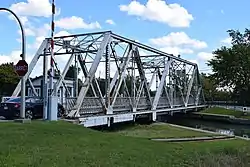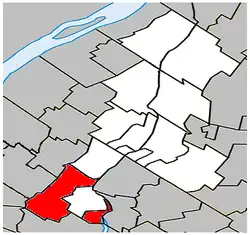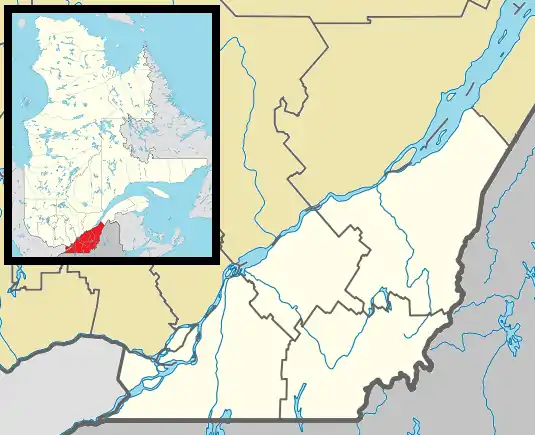Carignan | |
|---|---|
 Bridge over Chambly canal in Carignan. | |
.svg.png.webp) Coat of arms | |
 Location within La Vallée-du-Richelieu RCM. | |
 Carignan Location in southern Quebec. | |
| Coordinates: 45°27′N 73°18′W / 45.450°N 73.300°W[1] | |
| Country | |
| Province | |
| Region | Montérégie |
| RCM | La Vallée-du-Richelieu |
| Constituted | July 1, 1855 |
| Government | |
| • Type | Carignan City Council |
| • Mayor | Patrick Marquès |
| • Federal riding | Beloeil—Chambly |
| • Prov. riding | Chambly |
| Area | |
| • Total | 65.20 km2 (25.17 sq mi) |
| • Land | 62.07 km2 (23.97 sq mi) |
| Population (2021)[5] | |
| • Total | 11,740 |
| • Density | 189.1/km2 (490/sq mi) |
| • Pop 2016-2021 | |
| • Dwellings | 4,375 |
| Time zone | UTC−5 (EST) |
| • Summer (DST) | UTC−4 (EDT) |
| Postal code(s) | |
| Area code(s) | 450 and 579 |
| Highways | |
| Website | www |
Carignan is a suburban municipality in southwestern Quebec, Canada, on the Richelieu River in La Vallée-du-Richelieu Regional County Municipality, about 27 km (17 mi) from Montreal. The population as of the Canada 2021 Census was 11,740.
Carignan was originally the Village Municipality of Chambly. The village of Chambly was established in 1855, less than 10 years after the municipality of Chambly. In 1965 it was renamed Carignan[6] to honour the Carignan-Salières Regiment.
Geography
-Rivi%C3%A8re_l'Acadie-Vue_vers_l'amont_du_pont_de_la_route_112_reliant_Chambly_et_Carignan-2022-08-29.jpg.webp)
-Pont_de_la_route_112_(boul._de_P%C3%A9rigny)_enjambant_la_rivi%C3%A8re_L'Acadie-2022-08-29.jpg.webp)
Carignan is made up of small urban blocks surrounded by agricultural land where the main crops grown are corn, wheat and soybeans. The municipality borders the Acadia and Richelieu rivers and these merge, creating a small delta. At their tip, one of the city's four islands: Île Goyer (formerly Grande Isle since it is the largest). Also, Île Demers and Île Aux Lièvres Between the islands, there are channels containing unique flora and fauna. Unusual fact, the municipality is cut (to the east and west) by the city of Chambly in two non-contiguous portions: there is a discontinuity of 1.8 km on the chemin de la Grande-Ligne and 3 km by the Richelieu River.
History
-%C3%89cole_Carignan-Sali%C3%A8res-2022-08-29.jpg.webp)
-Patinoire_couverte_sur_la_rue_de_l'%C3%89cole-2022-08-29.jpg.webp)
The current city of Carignan was created on July 1, 1855 on a territory known as Chambly. The original name of Carignan was Saint-Joseph-de-Chambly and it kept this name for more than a century. On June 6, 1871, a large part of Saint-Joseph-de-Chambly broke apart (as well as an important section of Saint-Bruno-de-Montarville) to form the new town of Saint-Basile-le-Grand. Finally, on December 31, 1965, the name Saint-Joseph-de-Chambly was changed to become the new city of Carignan.
Demographics
In the 2021 Census of Population conducted by Statistics Canada, Carignan had a population of 11,740 living in 4,274 of its 4,375 total private dwellings, a change of 24.1% from its 2016 population of 9,462. With a land area of 62.07 km2 (23.97 sq mi), it had a population density of 189.1/km2 (489.9/sq mi) in 2021.[7]
|
Population trend:[8]
|
Mother tongue language (2021)[9]
|
Transportation
The CIT Chambly-Richelieu-Carignan provides commuter and local bus services.
See also
References
- ↑ "Banque de noms de lieux du Québec: Reference number 10732". toponymie.gouv.qc.ca (in French). Commission de toponymie du Québec.
- 1 2 "Ministère des Affaires municipales, des Régions et de l'Occupation du territoire: Carignan". Archived from the original on 2013-04-27. Retrieved 2012-03-11.
- ↑ Parliament of Canada Federal Riding History: CHAMBLY--BORDUAS (Quebec)
- ↑ 2021 Statistics Canada Census Profile: Carignan, Quebec
- ↑ "Census Profile, 2021 Census - Carignan, Ville [Census subdivision], Quebec and Canada [Country]". 8 February 2017.
- ↑ "Fiche descriptive".
- ↑ "Population and dwelling counts: Canada, provinces and territories, and census subdivisions (municipalities), Quebec". Statistics Canada. February 9, 2022. Retrieved August 29, 2022.
- ↑ Statistics Canada: 1996, 2001, 2006, 2011, 2016, 2021 census
- ↑ 2021 Statistics Canada Community Profile: Carignan, Quebec